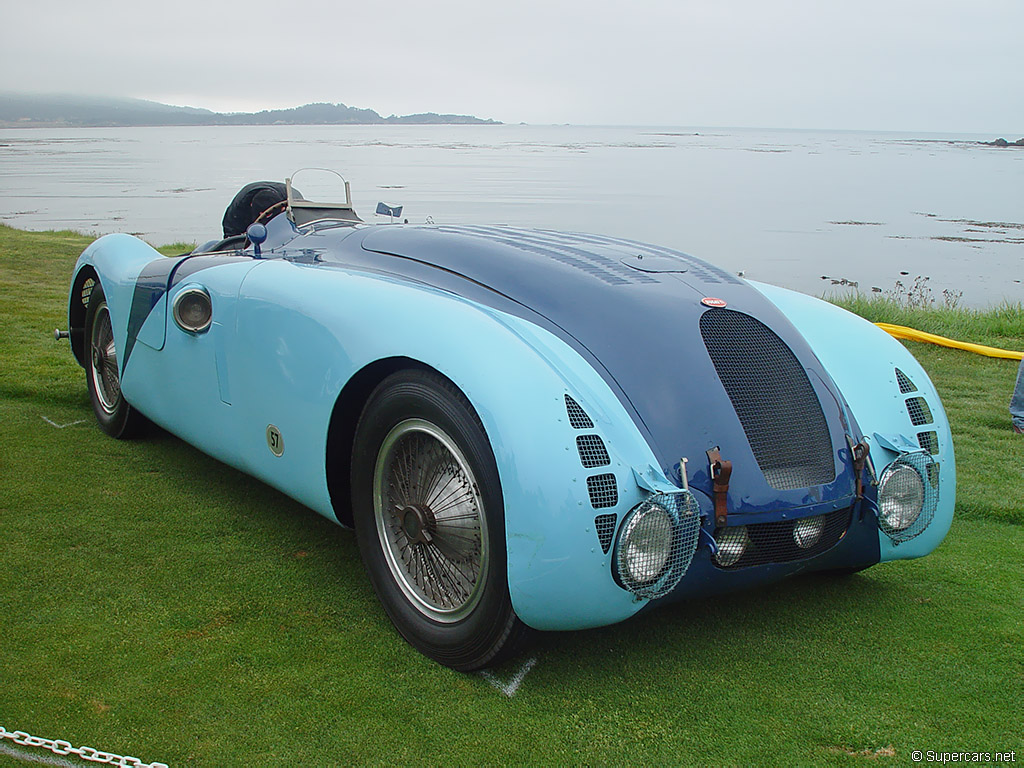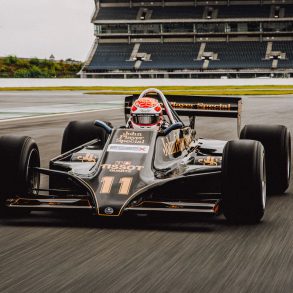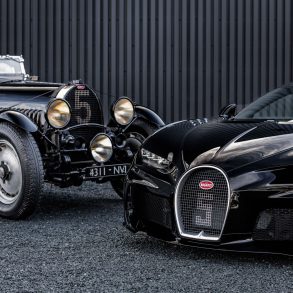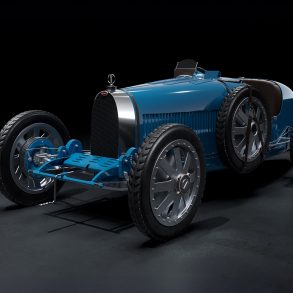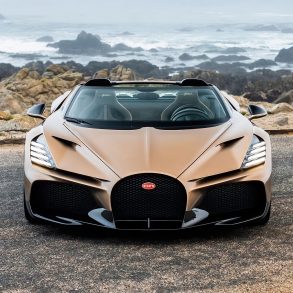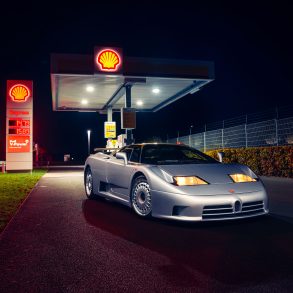Bugatti 57G Tank
Car: Bugatti 57G / Engine: Inline-8 / Maker: Bugatti / Bore X Stroke: 72 mm x 100 mm / Year: 1936 / Capacity: 3257 cc / Class: GP / Sports Car / Power: 149.1 kw / 200 bhp / Wheelbase: 2979 mm / Track: Front: 1349 mm Rear: 1349 mm / Weight: 1265 kg / Note: Some variants including the 1937 Le Mans winner had supercharged engines.
Gianoberto Carlo Rembrandt Ettore Bugatti, known as Jean, was the eldest son of Ettore Bugatti and the most gifted of his four children. From the late 1920s onwards, Jean used his own structural and design ideas to exert more and more influence over the development of the company located in Molsheim, Alsace.
With the German Silver Arrows dominating the Grand Prix scene Jean convinced his father that Bugatti should develop a sports car which could be used for long distance competitions. He suggested that the recently introduced Type 57, a car of his design coincidently, could form the solid basis for a winning car. Several variants would be built some using a special lowered chassis, the T57S or surbaissé (lowered or low-slung) powered with a blown or compressor engine (T57C). They were fitted with an aerodynamically designed magnesium alloy bodywork and thus called “tanks”. Bugatti concurrently developed its sibling the T59 and raced this car when required by the specific rules of the event. The cars shared a common engine design architecture, yet each version is different in many details and materials. Just to further confuse matters they were often generically referred to as the Type 57G.
As if on queue the French, tired of being beaten by their German rivals decided that the ACF Grand Prix would feature “participation” of Grand Touring cars. This category included their definition of a sports cars. The Germans were uninvited less they show up with a team of modified streamliners. In response two Tanks were assembled for the race that would be held at Montlhery on the 28th of June.
The cars would be driven by Wimille/Sommer and Veyron/Williams. The influence of Jean Bugatti on their design as well as preparation was unmistakable. That year at the age of 27 Jean Bugatti had taken over the day to day running of the company. On June 8th and 9th the two cars were taken to the track and driven the entire 1000km distance. The cars ran trouble-free throughout the test with one car recording a fastest lap of 134.33 kph. On the second day of practice Pierre Veyron driving on the Autodrome (banked) section of the circuit would record a speed of 208.5 kph hitting 215 kph on the straight. All this was accomplished in front of Charles Faroux, the legendary French journalist just to make sure word got out to the Talbot and Delahaye teams.
The race was easily won by the Bugatti driven by Jean-Pierre Wimille and Raymond Sommer, at an average speed of 125.228 km/h for just under 8 hours. One week later, on July 7, at the Grand Prix de la Marne organized by the Automobile Club de Champagne and staged at the Circuit Reims-Gueux, Wimille again won in a 57G at an average of 140.245 km/h.
The following year a 4.7 special bodied Type 57S45 Tank streamliner briefly performed in practice prior to the Grand Prix at Montlhery but astonishingly it appears that Benoist took the car around the Autodrome without the formal permission of track officials, so was promptly disqualified from the race. Ettore Bugatti not one to take a perceived slight lightly promptly decided not to enter any of his cars for the race.
In June Wimille and Robert Benoist, driving a Type 57SC variant powered by a supercharged engine producing 200 bhp, won the 24 hours of Le Mans, the first time a Bugatti had ever prevailed in a major sports car race. Unfortunately the race was marred by the death of two drivers in a single accident. Briton Pat Fairfield and Frenchman René Kippeurt collided on lap 8 of the race and were both killed, Kippeurt instantly and Fairfield later due to internal injuries. Wimille, who was just up the road, managed to just avoid the carnage.
Having proved his point, if any point need proving with the 1937 victory, Ettore Bugatti stated that he wouldn’t return, until his record of that year was beaten. In 1938 a Delage took the victory, however, at a lower average. Jean had to convince his father to enter the 1939 edition, finally he relented but Bugatti would participate only under the following condition: Only one car was to be entered: “As there is never more than one winner, one car only must be enough.”
And so it would be a single Bugatti against six Talbot’s. three of them of 4.5 litre, 8 Delahaye’s (six 135MS), two Delage 3 litres, a majestic Alfa 2500SS coupe driven by Sommer, and two Super Lagonda V12 4.5 litres, designed by a certain W.O. Bentley. During the second practice session disaster struck when the engine broke down, all would seem lost. Wimille, Veyron and Jean Bugatti considered abandoning the race but chief mechanic Robert Aumaître had other ideas. A call was placed to Molsheim and replacement parts were rushed to the track, fittingly by Bugatti’s own Autorail rail car. Improbably the car is repaired just prior to the start. After the leading Delage driven by Louis Gerard suffers engine failure Wimille is able to claim Bugatti’s second Le Mans title and last major victory. Wimille would later state that of all the cars that he had raced during his career he enjoyed racing the Bugatti’s the most.
Robert Aumaître later relates what happened to the Bugatti Museum.
A mechanic at Molsheim was put on a train to Paris with the pistons Benoist was sent to Gare de l’Est to collect the new pistons but they were oversized. Aumaître worked for 12 hours in a local engineering works to prepare the block. Veyron was sent out to collect cold food as they didn’t stop for lunch. Aumaître finished the block at about midnight on Friday, grabbed some sleep while the team assembled the engine and at 7 the next morning Robert took the car out for a brief run. Veyron was sent out to do 100 or 200 km to run the car in but to be back by 11. They got the car to the circuit by midday, the race started at 4 and they won at record speed.
Though his father forbade him to enter races, he volunteered as a test driver whenever the opportunity presented itself. Shortly before the outbreak of World War II, on August 11, 1939, Jean Bugatti crashed the Type 57C Tank he was test-driving – the same car that had just recently won the 24-hour race at Le Mans. At more than 200 km/h, he had to swerve to avoid hitting a bicyclist coming out of a country lane. He lost control of the car, hit a tree, and died on the spot. At the time of his tragic death, Jean Bugatti was only 30 years old. A distraught Ettore Bugatti had the remains of the car buried on factory grounds never to be recovered.




